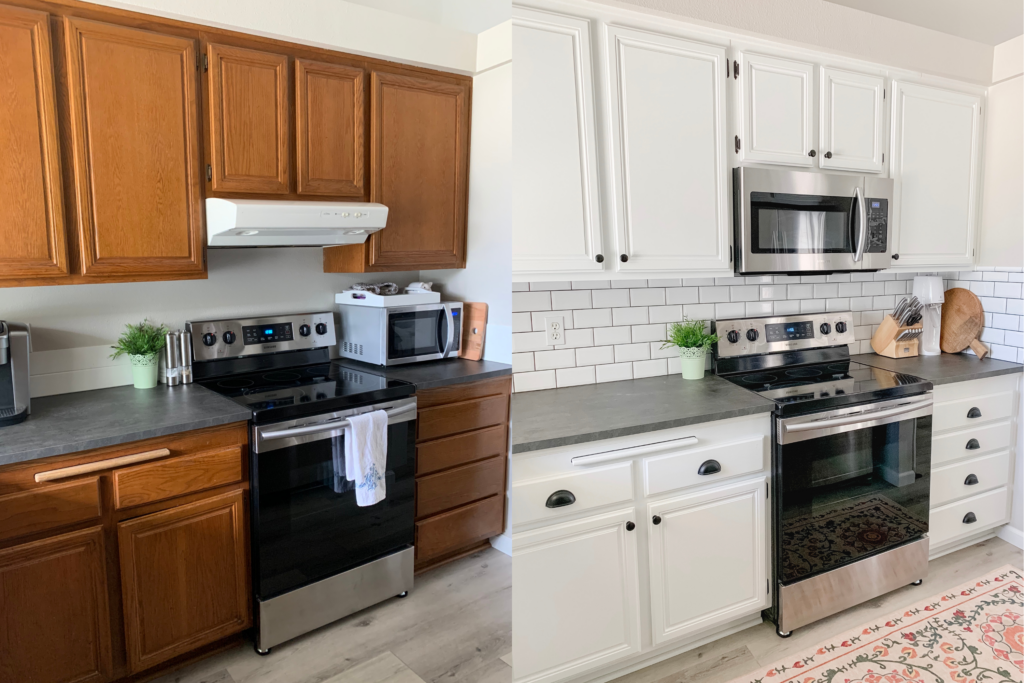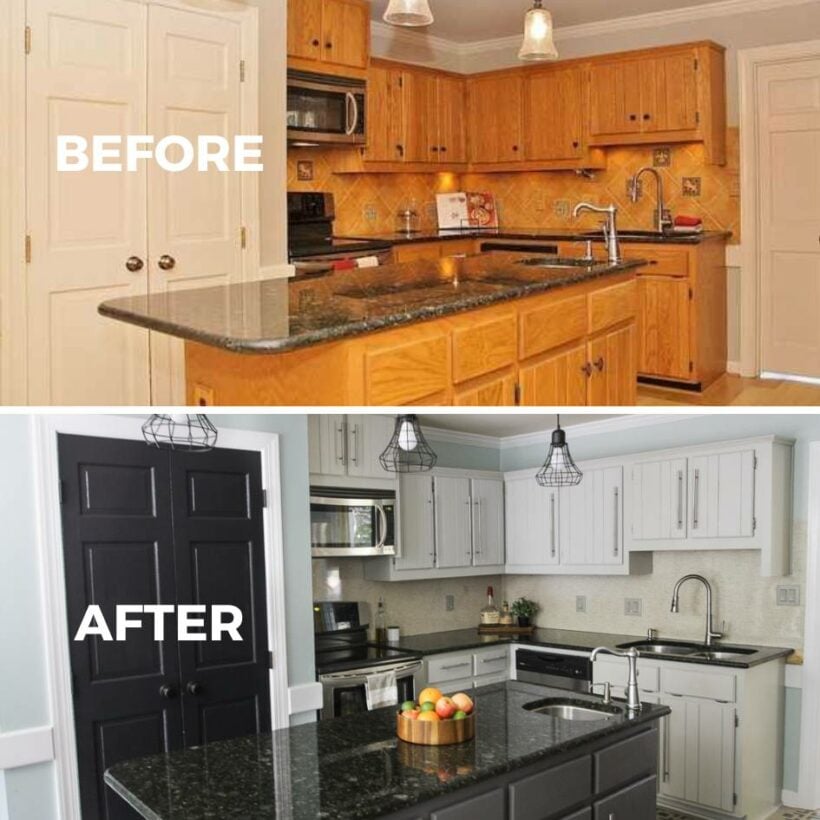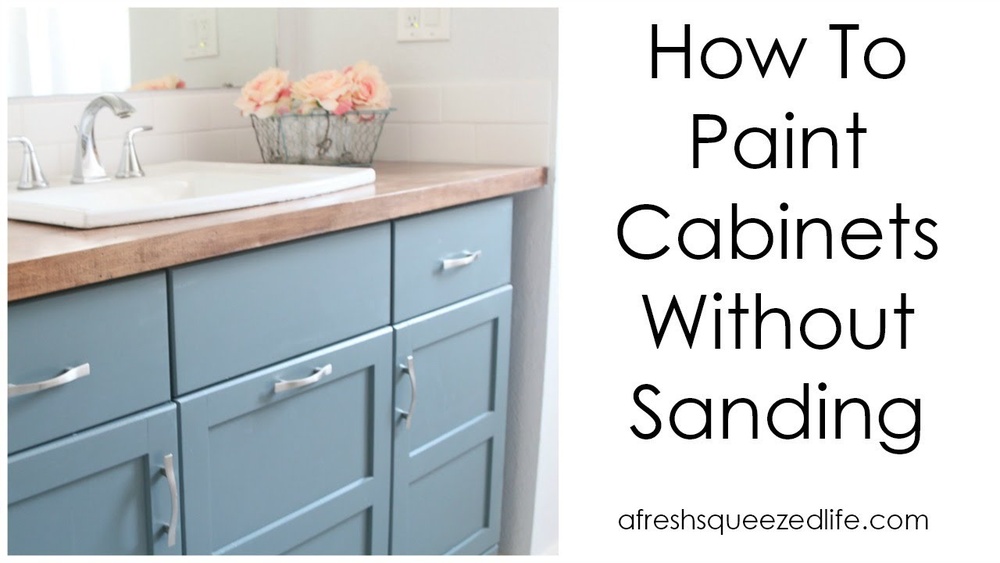Thinking about giving your kitchen a fresh look without the mess and hassle of sanding your cabinets? You’re not alone.
Sanding can be time-consuming, dusty, and downright exhausting. But what if you could skip that step and still achieve a smooth, long-lasting finish? In this guide, you’ll discover simple, effective ways to paint your kitchen cabinets without sanding—saving you time and effort while transforming your space.
Ready to learn the secrets that pros use to get great results without the usual prep work? Keep reading, because your dream kitchen makeover is easier than you think.

Reasons To Skip Sanding
Skipping sanding saves a lot of time during kitchen cabinet painting. It cuts down the preparation phase significantly. Without sanding, you avoid the long process of smoothing surfaces.
There is less dust and mess to clean up, which keeps your kitchen cleaner. This is great for indoor projects, especially in small spaces.
Painting without sanding works best if the cabinet surface is smooth and in good shape. Cabinets with minimal damage or glossy finish respond well to this method. Using a liquid deglosser or a bonding primer helps paint stick properly.
Essential Materials
Start with degreasing cleaners to remove all dirt and grease. This step is key for paint to stick well. Use a liquid deglosser to dull the shiny finish on cabinets. It helps the primer grip the surface without sanding. A bonding primer is needed next. It creates a strong base for the paint. Choose a primer made for slick surfaces like laminate or varnished wood.
Select paint types designed for cabinets or furniture. Acrylic latex or oil-based paints work best. Use quality brushes or foam rollers to get a smooth finish. A small angled brush helps with corners and edges. Let each coat dry fully before applying the next for the best results.
Preparing Cabinets Without Sanding
Start by cleaning the cabinets well. Use warm water mixed with mild soap. Remove all grease, dirt, and stains. This step is very important because paint will not stick to dirty surfaces.
Next, apply a liquid deglosser to the cabinet surfaces. This product helps to remove shine and creates a rough texture for paint to stick. Use a clean cloth to wipe the deglosser on evenly. Let it dry completely before painting.
Check the surface carefully. It should feel clean and slightly rough. If there are sticky or shiny spots, repeat the deglosser step. This ensures better paint adhesion without sanding.

Applying Primer And Paint
Choosing the right primer is key for painting cabinets without sanding. Use a bonding primer designed for slick surfaces. This helps paint stick well and last longer. Avoid regular primers that may peel off.
Primer application tips include cleaning cabinets first with a degreaser. Apply primer in thin, even coats using a brush or roller. Let each coat dry fully before adding another. This prevents drips and uneven texture.
Painting techniques for a smooth finish involve using a high-quality paintbrush or foam roller. Paint in long, steady strokes along the grain of the wood. Apply two or three thin coats rather than one thick coat. Sanding between coats is optional but can improve smoothness.
Common Mistakes To Avoid
Skipping cleaning steps leads to poor paint adhesion. Dirt and grease block paint from sticking well. Always use a good cleaner before painting.
Using incorrect primer can cause peeling or chipping later. A bonding primer made for slick surfaces works best. It helps paint stick without sanding.
Applying paint too thickly causes drips and uneven finish. Thin, even coats dry faster and look smoother. Let each coat dry fully before adding another.
Maintaining Painted Cabinets
Allow painted cabinets to cure for at least 24 to 48 hours. This helps the paint harden and last longer. Avoid heavy use during this time. Use gentle cleaning methods to keep the paint looking fresh. A soft cloth with mild soap works well. Harsh cleaners can damage the paint.
For small scratches or chips, keep some paint handy for quick touch-ups. Dab gently with a small brush. This keeps cabinets looking new without a full repaint.
When Sanding Might Be Necessary
Damaged or peeling surfaces often need sanding. Paint and wood chips must be removed. Painting over damaged areas can cause poor results and peeling paint later. Sanding fixes these problems by creating a smooth base.
For glossy or laminate cabinets, sanding is usually required. Glossy finishes are hard for paint to stick to. Sanding helps roughen the surface so the paint bonds well. Without sanding, paint may peel or chip quickly.
Long-term durability concerns also suggest sanding. Cabinets get daily use and need a strong finish. Sanding helps primer and paint stick better, lasting longer. Skipping sanding may reduce the paint’s lifespan and cause frequent touch-ups.

Tools And Products Recommendations
Top degreasers and deglossers help remove grease and shine. Choose products like Krud Kutter or TSP (trisodium phosphate) for deep cleaning. These make surfaces ready for paint by removing oils and dirt. Deglossers like Liquid Sandpaper dull the surface without sanding, helping paint stick better.
Best bonding primers create a strong base on glossy or smooth cabinets. Options such as Zinsser Bulls Eye 1-2-3 or KILZ Adhesion work well. These primers stick well to non-sanded surfaces and prevent peeling. They improve paint durability and finish.
Preferred paints and finishes include acrylic latex paint or cabinet-specific paints. Semi-gloss or satin finishes are popular for kitchens because they clean easily. Use a brush or foam roller for smooth, even coats. Multiple thin layers give better results than one thick coat.
Frequently Asked Questions
Can You Paint Over Cabinets Without Sanding?
Yes, you can paint cabinets without sanding by cleaning thoroughly, using a liquid deglosser, and applying a strong bonding primer. This method saves time but relies on primer for paint adhesion and durability.
Can I Just Paint Over My Kitchen Cabinets?
You can paint over kitchen cabinets without sanding by cleaning thoroughly, using a liquid deglosser, and applying a strong bonding primer. This ensures paint adhesion and durability, saving time but may affect long-term finish quality.
Is It Better To Brush Or Roll Paint On Kitchen Cabinets?
Rolling paint on kitchen cabinets offers faster, smoother coverage with fewer brush marks. Brushing provides better control for detailed areas. Combine both: roll large surfaces, then brush edges for a professional finish.
What Is The Easiest Way To Paint Kitchen Cabinets?
The easiest way to paint kitchen cabinets is to clean thoroughly, apply a liquid deglosser, use a bonding primer, then paint.
Conclusion
Painting kitchen cabinets without sanding saves time and effort. Clean the surfaces well to remove grease and dirt. Use a liquid deglosser to help paint stick better. Apply a strong bonding primer for durability and smooth finish. Choose quality paint and apply it evenly with a brush or roller.
This method refreshes cabinets without the mess of sanding. Enjoy a fresh kitchen look with less work and great results. Simple steps can make a big difference in your home’s style.

Yes, working as , Food Blogger and Product Reviewer for last 6 years. Here you will get amazing deals for Smart kitchen products. I am your best source for the latest update in cooking trends. I provide insightful articles, reviews, and analysis on cutting-edge kitchen gadget. My mission is to empower readers with the knowledge they need to stay ahead in a rapidly evolving coking world. Join me as we explore the future of food technology and how it shapes our lives today and tomorrow.





